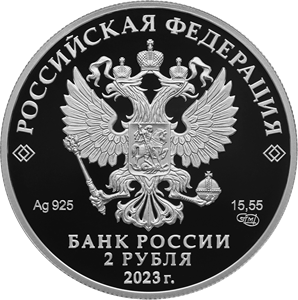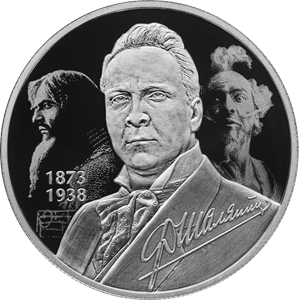Opera Singer Feodor Chaliapin, the 150th Anniversary of his Birth
Obverse
a relief image of the National Coat of Arms of the Russian Federation and a semicircular inscription above it along the rim: ‘РОССИЙСКАЯ ФЕДЕРАЦИЯ’ (RUSSIAN FEDERATION) framed with paired diamonds on both sides, under the coat of arms there are the chemical symbol of the metal and fineness on the left and fine metal content and the mint trade mark on the right, at the bottom in the centre, in three lines, there is an inscription: ‘БАНК РОССИИ’ (BANK OF RUSSIA), the coin denomination: ‘2 РУБЛЯ’ (2 RUBLES), and the year of issue: ‘2023 г.’ (2023).
Reverse
a relief image of Feodor Chaliapin’s portrait against the background of images of his stage personas and a fragment of the stave, laser treated for matte finishing, the facsimile of the singer’s signature – below on the right, and the years of his birth and death ‘1873’ and ‘1938’ in two lines on the left.
Authors
Designers: E.V. Kramskaya (obverse), A.V. Baklanov, National Artist of Russia (reverse).
Sculptors: A.A. Dolgopolova (obverse), A.N. Bessonov (reverse).
Mint: Saint Petersburg Mint (СПМД).
Edge: 195 corrugations.
Discover more
Feodor Chaliapin (1873–1938) was a Russian opera singer who performed at major opera houses of the world, including the Bolshoi Theatre, the Mariinsky Theatre, and the Metropolitan Opera. His talent was admired by composers Sergei Prokofiev and Anton Rubinstein, music critic Vladimir Stasov who called him a ‘great artist’, and Maxim Gorky who believed that Chaliapin represented a whole epoch in Russian art.
Feodor Chaliapin started singing when he was a child. He was born into a peasant family in Kazan, sang in a choir, and performed at village feasts. When Chaliapin was aged 22, he debuted at the Mariinsky Theatre as Mephistopheles in Gounod’s Faust. A year later, Savva Mamontov invited the singer to the Moscow Private Opera. The young bass singer performed as Ivan the Terrible in Rimsky-Korsakov’s The Maid of Pskov, Dosifey in Khovanshchina and Godunov in Boris Godunov by Modest Mussorgsky. Each of his performances was sold out.
Very skilful in greasepaint, Chaliapin created stage personas adding bright images to his vigorous singing, as if sculpting his face. His contemporaries compared the singer’s style of greasepaint with Korovin’s and Vrubel’s paintings.
In 1899, Chaliapin became the lead singer at two main theatres of the country – the Bolshoi and Mariinsky Theatres. His success was really enormous, so that his contemporaries joked that there were three miracles in Moscow: the Tsar Bell, the Tsar Cannon, and the Tsar Bass – Feodor Chaliapin.
In 1918–1921, Chaliapin was the artistic director of the Mariinsky Theatre. In 1918, the Tsar Bass became the first man of art to be granted the title of People’s Artist of the Republic.
Travelling around the world with his concerts, the singer had many performances at the Russian Opera House and created a whole ‘theatre of romantic songs’. Chaliapin’s high bass was well known and adored in Italy, France, Germany, the USA, and the UK. His repertoire included nearly 400 compositions.
Source: https://www.culture.ru


